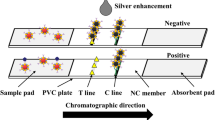Abstract
Immunoassays for heavy metals offer an alternative approach to traditional techniques for detection of mercury. In this study, a mercury-chelate was prepared with 1-(4-aminobenzyl) ethylenediamine-N,N,N′,N′-tetraacetic acid (aminobenzyl-EDTA). The resulting complex was linked to keyhole limpet hemocyanin (KLH) or bovine serum albumin via the amino group and used as the immunizing antigen or detection antigen, respectively. BALB/c mice were immunized with KLH-aminobenzyl-EDTA-Hg and spleen cells from BALB/C mice were fused with Sp2/0 cells. One cell line (5F7) produced monoclonal antibodies with preferential selectivity and sensitivity for aminobenzyl-EDTA-Hg. This cell line had an affinity constant of 4.31 × 109 L/mol and its cross-reactivity (CR) with other metals was <2%. The antibody was used for competitive indirect ELISA (CI-ELISA) for Hg2+ measurements. The detection range was 0.087–790.4 μg/L and the lower limit of detection was 0.042 μg/L. The concentrations of mercury in environmental water samples obtained by CI-ELISA correlated well with graphite furnace atomic absorption spectrometry (GFAAS), and the mean recovery was 88.82% to 104.64%. These results indicate that this method could be used for monitoring mercury of water.



Similar content being viewed by others
References
Rubio C, Gonzalez-Iglesias T, Revert C et al (2005) Lead dietary intake in a Spanish population (Canary Islands). J Agric Food Chem 53:6543–6549
Abernathy AR, Cumbie PM (1977) Mercury accumulation by largemouth bass (Micropterus salmoides) in recently impounded reservoirs. Bull Environ Contam Toxicol 17:595–602
Cox JA, Carnahan J, DiNunzio J et al (1979) Source of mercury in fish in new impoundments. Bull Environ Contam Toxicol 23:779–783
Verdon R, Brouard D, Demers C et al (1991) Mercury evolution (1978–1988) in fishes of the La Grande hydroelectric complex, Quebec, Canada. Water Air Soil Pollut 56:405–417
Tremblay A, Lucotte M, Rheault I (1996) Methylmercury in a benthic food web of two hydroelectric reservoirs and a natural lake of northern Quebec (Canada). Water Air Soil Pollut 91:255–269
Myers GJ, Davidson PW, Cox C et al (2003) Prenatal methylmercury exposure from ocean fish consumption in the Seychelles child development study. Lancet 361:1686–1692
Bloom NS, Gill GA, Cappellino S et al (1999) Speciation and cycling of mercury in Lavaca Bay, Texas, sediments. Environ Sci Technol 33:7–13
Chasar LC, Scudder BC, Stewart AR et al (2009) Mercury cycling in stream ecosystems. 3. Trophic dynamics and methylmercury bioaccumulation. Environ Sci Technol 43:2733–2739
Wang L, Jia G (2005) Progress in developmental toxicity of methylmercury. J Hyg Res 34:633
Jackson KW, Chen G (1996) Atomic absorption, atomic emission, and flame emission spectrometry. Anal Chem 68:231–256
Saouter E, Blattmann B (1994) Analyses of organic and inorganic mercury by atomic fluorescence spectrometry using a semiautomatic analytical system. Anal Chem 66:2031–2037
Szurdoki F, Jaeger L, Harris A et al (1996) Rapid assays for environmental and biological monitoring. J Environ Sci Health B 31:451–458
Khosraviani M, Blake RC II, Pavlov AR et al (2000) Binding properties of a monoclonal antibody directed toward lead-chelate complexes. Bioconjug Chem 11:267–277
Blake RC II, Pavlov AR, Khosraviani M et al (2004) Novel monoclonal antibodies with specificity for chelated uranium (VI): isolation and binding properties. Bioconjug Chem 15:1125–1136
Chakrabarti P, Hatcher FM, Blake RC et al (1994) Enzyme immunoassay to determine heavy metals using antibodies to specific metal-EDTA complexes: optimization and validation of an immunoassay for soluble indium. Anal Biochem 217:70–75
Xiang J, Zhai Y, Tang Y et al (2010) A competitive indirect enzyme-linked immunoassay for lead ion measurement using mAbs against the lead-DTPA complex. Environ Pollut 158:1376–1380
Mariani M, Bartolazzi A, Camagna M et al (1991) Monoclonal antibodies to a soluble metallic radioisotope chelator: development and characterization. Hybridoma 10:695–705
Kishiro Y, Kagawa M, Naito I et al (1995) A novel method of preparing rat-monoclonal antibody-producing hybridomas by using rat medial iliac lymph node cells. Cell Struct Funct 20:151–156
Blake DA, Chakrabarti P, Khosraviani M et al (1996) Metal binding properties of a monoclonal antibody directed toward metal-chelate complexes. J Biol Chem 271:27677
Reik LM, Maines SL, Ryan DE et al (1987) A simple, non-chromatographic purification procedure for monoclonal antibodies Isolation of monoclonal antibodies against cytochrome P450 isozymes. J Immunol Methods 100:123–130
Beatty JD, Beatty BG, Vlahos WG (1987) Measurement of monoclonal antibody affinity by non-competitive enzyme immunoassay. J Immunol Methods 100:173–179
Jones G, Wortberg M, Kreissig SB et al (1994) Extension of the four-parameter logistic model for ELISA to multianalyte analysis. J Immunol Methods 177:1–7
Darwish IA, Blake DA (2001) One-step competitive immunoassay for cadmium ions: development and validation for environmental water samples. Anal Chem 73:1889–1895
Wengatz I, Harris AS, Gilman SD et al (1996) Recent developments in immunoassays and related methods for the detection of xenobiotics. In: Environmental Immunochemical Methods, vol 646. ACS Symposium Series. ACS Publications, Washington. pp 110–126
Acknowledgment
This work was supported by the National “863” Project (2007AA10Z440) of China and the National Natural Science Foundation of China (Nos. 30972224, 31072178, and 30871897).
Author information
Authors and Affiliations
Corresponding authors
Additional information
Xiaobing LI and Guowen LIU contributed equally to this study.
Rights and permissions
About this article
Cite this article
Zhang, Y., Li, X., Liu, G. et al. Development of ELISA for Detection of Mercury Based on Specific Monoclonal Antibodies Against Mercury-Chelate. Biol Trace Elem Res 144, 854–864 (2011). https://doi.org/10.1007/s12011-011-9031-z
Received:
Accepted:
Published:
Issue Date:
DOI: https://doi.org/10.1007/s12011-011-9031-z




